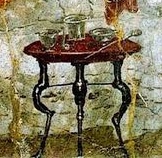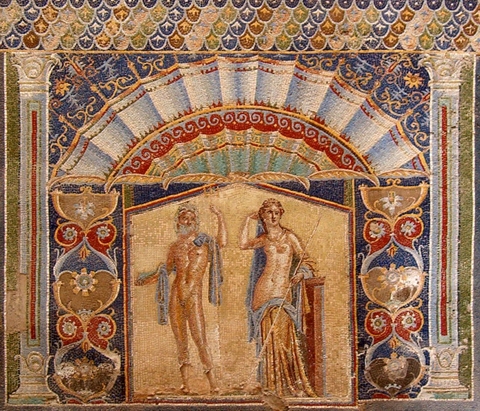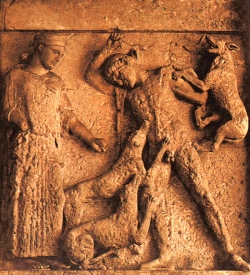 |
 |  |  |  |  |  |  |  |  |  |  | | |

ARREDI E SUPPELLETTILI Il fatto che Ercolano sia stata distrutta e sepolta da fango piroclastico incandescente (tempe-
ratura tra i 400 e i 500 gradi), ha determinato l'istantanea carbonizza-
zione e mineralizzazio-
ne dei materiali lignei degli arredi e di molti tipi di alimenti. Sono giunti intatti a noi, oltre a forme di pane, frutta e residui alimentari di vario tipo, una discreta quan-
tità di mobili e suppel-
lettili: triclini, casse con il relativo contenuto, la-
rari, utensili da cucina, torchi, vasellame anche prezioso, oreficeria.

| |
|
|
 |
 |
|
| 
 |
|

| | Dionigi da
Alicarnasso
attribuì la sua fonda-
zione al mitico eroe Ercole, ma la
sua origi-
ne è Italica
(Osca). Passò poi, con alterne vicende, sotto il dominio
dei greci, che ne
disegnano l’impianto urbanistico ortogonale a Cardini e
Decumani, dei Sanniti
ed infine dei Romani, sotto il cui dominio raggiunse il
massimo splendore con
una ricchezza di dimore nobili di cui la Villa
di Pisone (Villa dei Papiri, per il gran
numero di papiri rinvenuti nella sua libreria) è l’esempio
più fulgido. Dopo la
tragica eruzione del 79 d.C., gli scavi, di difficile
attuazione per la
notevole altezza e durezza del fango lavico che per secoli
l’aveva custodita, si
sono svolti con campagne condotte da importanti tecnici ed
archeologi lungo l’arco
di tre secoli, dal 1709 (anno del primo rinvenimento) ad
oggi: il Principe D’Elboeuf,
l’ingegnere militare Alcubierre, il Weber, il La Vega,
l’architetto Bonucci,
Giuseppe Fiorelli, Amedeo Maturi, sono i nomi dei più
famosi. Oggi il nostro
sguardo può spaziare solo su parte della città morta,
poiché quella attuale la sovrasta
indisturbata celandoci chissà quante altre meraviglie.
Rispetto a Pompei qui le
vie e le botteghe risuonano meno degli immaginari rumori
di antichi mestieri, dove
numerosi turisti intuiscono ritmi pacati di vita quotidiana: silenziosamente ci si incunea, attraverso ombreggiati e magnifici atri, nelle ricche Domus, che conservano l'impianto distri-butivo delle case sannitiche, rapiti dagli affreschi e dai mosaici che le decorano.
 Dionysius
of Halicarnassus attributed the foundation of Herculaneum to the
mythical hero Hercules, but its origin is Italica (Osca). Then it
passed, with ups and downs, under the dominion of the Greeks, who draw
the urban orthogonal plan of the city characterized by Cardini and
Decumani, of the Samnites, and finally of the Romans, under whose rule
Herculaneum reached its peak with a wealth of patrician residences
among which theVilla of Pisoni is the brightest examples. The Villa
is also called Villa of the Papyri because during the excavations a
huge library of papyrus scrolls was discovered. After the tragic
eruption of 79 AD, excavations, difficult to implement for the great
height and hardness of the mud lava, were held with major campaigns and
conducted by engineers and archaeologists over the course of three
centuries, from 1709 (first year of discovery) to nowadays: the name of
the most famous are:the Prince D'Elboeuf, the military engineer
Alcubierre, Weber, La Vega, the architect Bonucci, Giuseppe Fiorelli,
Amedeo Maiuri, . Today, our eyes can range only part of the dead city,
since the actual city dominates undisturbed..who knows how many other
wonders the town of Resina still keep underneath . Here the streets
,comparing them to those of Pompei , reechoes of the imaginary
noises of ancient crafts,, the tourists seem to hear.: We silently get
through shady and magnificent foyer (Atrium), in the very rich houses
(Domus), which preserve the system of distribution of the Samnite
houses, we can’t help admiring the frescoes and mosaics that decorate
them.
| | Miti | Il
mito, che rappresentava il leit-motiv degli affreschi di Pompei, aveva
l’intento di erudire su eventi passati della storia greca, indicando la
strada per seguire l’itinerario dell’uomo diviso fra istintualità e
razionalità. Il mito nel tempo aveva fortificato gli uomini, concedendo
il lasciapassare ad un’anima afflitta dalle paure, dalle angosce, dalle
ombre della natura, dal ritmo vitale di inizio e fine, verso un ordine
presentato anche nel più crudele e terrificante dei modi. La meraviglia
del mito dipinto direttamente sulle pareti domestiche delle Domus
pompeiane affascina anche l’uomo moderno che trova nelle raffigurazioni
antichissime, attinenza con le teorie psicoanalitiche attuali. Ci si
rende conto che la scena mitologica può essere un codice universale di
intenti nella chiarificazione di atteggiamenti, abitudini, riti che
hanno sempre avuto come protagonista un uomo fragile, debole, che cerca
risposte.
Il mito allude alla metamorfosi che si determina nel momento in cui l'stinto predomina sulla ragione: l'impatto contro il muro della liceità è brusco e terrifico per chi osa. Atteone, figlio di Aristeo e di Autonoe, fu il celebre eroe e cacciatore troiano, mutato da Artemide in cervo e divorato poi dai suoi stessi cani per aver visto la dea fare il bagno nuda.

Myths The
myth, which was the leit motif of the frescoes of Pompeii, had the
intent to inform people on the past events of the Greek history,
leading the way to follow the 'path’ of man torn between instinct and rationality. The myth strengthened over time men, giving a pass to a soul, beset
by fears and anxieties, by the shadows of nature, by the rhythm of
life , by the beginning to the end, even in an order presented
through the most cruel and terrifying ways. The marvel of the myth
painted directly on the walls of the domus (house) of Pompei also
fascinates the modern man who find in the very ancient depiction
current meaning bound to psychoanalytic theories. You realize that the
mythological scene may be an universal code of intent for the
clarification of attitudes, habits, rituals; they have always had as
their protagonist a weak man, looking for answers. So the classic myth
of Pompei grew and became an instrument of scholarly knowledge. Myth of Atteone The
myth refers to the metamorphosis that determines when the instinct
prevails over reason, the impact on the ‘wall of legality’ is abrupt and
terrifying for those who dare. Attaeone, son of Aristeo and Autonoe
,was the famous hero and the hunter of Troia. He was changed by Artemide into a stag and was devoured by his
own dogs. He was spying the naked goddess bathing.
| | |
 |
|
















